 W
WInsects have found uses in art, as in other aspects of culture, both symbolically and physically, from ancient times. Artforms include the direct usage of beetlewing (elytra) in paintings, textiles, and jewellery, as well as the representation of insects in fine arts such as paintings and sculpture. Insects have sometimes formed characteristic features of artforms, as in Art Nouveau jewellery.
 W
WThe Allegory of Divine Providence and Barberini Power is a fresco by Italian painter Pietro da Cortona, filling the large ceiling of the grand salon of the Palazzo Barberini in Rome, Italy. Begun in 1633, it was nearly finished in three years; upon Cortona's return from Venice, it was extensively reworked to completion in 1639. The Palazzo, since the 1620s, had been the palatial home of the Barberini family headed by Maffeo Barberini, by then Urban VIII, who had launched an extensive program of refurbishment of the city with art and architecture.
 W
WApparatus and Hand is a 1927 painting by Salvador Dalí. The painting currently resides at the Salvador Dalí Museum in St. Petersburg, Florida. This work is on loan from the collection of Mr. and Mrs. A Reynolds Morse.
 W
WBeetlewing, or beetlewing art, is an ancient craft technique using iridescent beetle wings practiced traditionally in Thailand, Myanmar, India, China and Japan.
 W
WThe Blind Girl (1856) is a painting by John Everett Millais which depicts two itinerant beggars, presumed to be sisters, one of whom is a blind musician, her concertina on her lap. They are resting by the roadside after a rainstorm, before travelling to the town of Winchelsea, visible in the background.
 W
WButterflies is a series paintings made by Vincent van Gogh in 1889 and 1890. Van Gogh made at least four paintings of butterflies and one of a moth. The metamorphosis of the caterpillar into a butterfly was symbolic to Van Gogh of men and women's capability for transformation.
 W
WDuring the reign of the ancient Egyptian pharaoh Amenhotep III hundreds of so-called memorial scarabs were issued to commemorate the deeds of the pharaoh. Such scarabs were found in several archaeological sites of the Near East, from Syria to Sudan. Over two hundred of them are known to exist in museums and collections around the world.
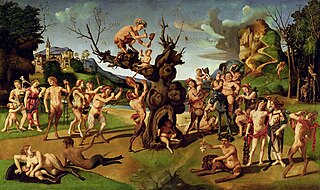 W
WThe Discovery of Honey by Bacchus is a painting by Piero di Cosimo from c. 1499. It depicts the god Bacchus and the discovery of honey, as described in the ancient Roman poem Fasti by Ovid. It is in the collection of the Worcester Art Museum in Worcester, Massachusetts.
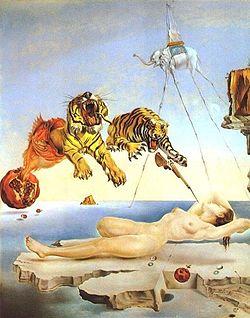 W
WDream Caused by the Flight of a Bee Around a Pomegranate a Second Before Awakening is a surrealist painting by Salvador Dalí. A shorter alternate title for the painting is Dream Caused by the Flight of a Bee. It was painted in 1944, and the woman in the painting, dreaming, is said to represent his wife, Gala. The painting is currently in the Thyssen-Bornemisza Museum, in Madrid.
 W
WDrosophila Fly Head is an outdoor 1988 sculpture by Wayne Chabre, installed on the University of Oregon campus in Eugene, Oregon, in the United States. The hammered copper sheet high-relief of a fly head measures approximately 3.5 feet (1.1 m) x 3 feet (0.91 m) x 2.5 feet (0.76 m). It was surveyed by the Smithsonian Institution's "Save Outdoor Sculpture!" program in March 1993, though its condition was undetermined. The sculpture is administered by the University of Oregon.
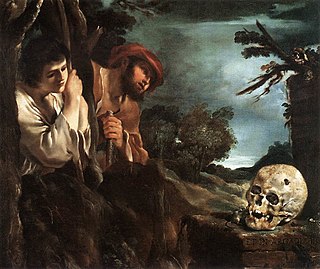 W
WEt in Arcadia ego is a painting by the Italian Baroque artist Giovanni Francesco Barbieri (Guercino), from c. 1618–1622. It is now on display in the Galleria Nazionale d'Arte Antica of Rome.
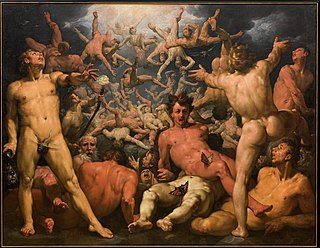 W
WThe Fall of the Titans is an oil painting of the Titanomachy by the Dutch painter Cornelis van Haarlem in 1588–1590. It measures 239 × 307 cm (94 × 121 in). The work is in the collection of the Statens Museum in Copenhagen, Denmark. It is an ambitious work of the Haarlem Mannerists, and a display of the artist's ability to devise and depict a large number of varied poses for the male nudes.
 W
WFishing for Souls is a 1614 oil on panel painting by the Dutch Golden Age artist Adriaen van de Venne in the collection of the Rijksmuseum.
 W
WFlower Garland with Butterfly is a lost painting by the Flemish artist Michaelina Wautier. It is suspected that the painting is a pendant of a similar still life, Flower Garland with Dragonfly. Both pictures have skulls at either side, follow a similar arrangement of the flowers, and were both painted in 1652.
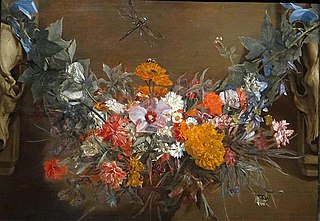 W
WFlower Garland with Dragonfly is a painting by the Flemish artist Michaelina Wautier. It was painted in 1652.
 W
WFlying Dragon is a sculpture by Alexander Calder in the Art Institute of Chicago North Stanley McCormick Memorial Court north of the Art Institute of Chicago Building in the Loop community area of Chicago, Illinois. It is a painted steel plate work of art created in 1975 measuring 365 (H) x 579 (L) x 335 (W) cm. It is painted in the signature "Calder Red" and is intended to represent a dragonfly in flight.
 W
WFontana del Tritone is a seventeenth-century fountain in Rome, by the Baroque sculptor Gian Lorenzo Bernini. Commissioned by his patron, Pope Urban VIII, the fountain is located in the Piazza Barberini, near the entrance to the Palazzo Barberini that Bernini helped to design and construct for the Barberini, Urban's family. This fountain should be distinguished from the nearby Fontana dei Tritoni by Carlo Francesco Bizzaccheri in Piazza Bocca della Verità which features two Tritons.
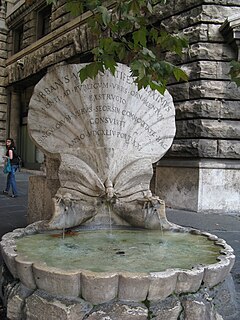 W
WFontana delle Api is a fountain located in the Piazza Barberini in Rome where the Via Veneto enters the piazza. It was sculpted by Gian Lorenzo Bernini and completed in April 1644.
 W
WGrasshopper is an outdoor 1988 copper sculpture by Wayne Chabre, located in Salem, Oregon, United States.
 W
WThe Great Masturbator (1929) is a painting by Salvador Dalí executed during the surrealist epoch, and is currently displayed at Museo Nacional Centro de Arte Reina Sofía, Madrid.
 W
WThe Hallucinogenic Toreador is a 1969–1970 multi-leveled oil painting by Salvador Dalí which employs the canons of his particular interpretation of surrealist thought. It is currently being exhibited at the Salvador Dalí Museum in St. Petersburg, Florida.
 W
WJohn Hampson (1836–1923)was an artist whose works hang at the Fairbanks Museum in Vermont. Hampson is known for his unusual mosaics formed of tens of thousands of insects, whether moths, butterflies, or beetles.
 W
WThe Haywain Triptych is a panel painting by Hieronymus Bosch, now in the Museo del Prado, Madrid, Spain. A date of around 1516 has been established by means of dendrochronological research. The central panel, signed "Jheronimus Bosch", measures 135 by 200 centimeters and the wings measure 147 × 66 cm. The outside shutters feature a version of Bosch's The Wayfarer.
 W
WThe Hireling Shepherd (1851) is a painting by the Pre-Raphaelite artist William Holman Hunt. It represents a shepherd neglecting his flock in favour of an attractive country girl to whom he shows a death's-head hawkmoth. The meaning of the image has been much debated.
 W
WThe Holy Family with the Dragonfly, also known as The Holy Family with the Mayfly, The Holy Family with the Locust and The Holy Family with the Butterfly is an engraving by the German artist Albrecht Dürer (1471–1528) from approximately 1495. It is quite small but full of intricate detail. A very popular image, copied by other printmakers within five years of creation, it is found in most major print room collections, including the Indianapolis Museum of Art and the UK Royal Collection.
 W
WThe Iran newspaper cockroach cartoon controversy occurred in response to a cartoon drawn by the cartoonist Mana Neyestani and published in the Iranian holiday-magazine Iran-e-jomee on 12 May 2006.
 W
WMetamorphosis II is a woodcut print by the Dutch artist M. C. Escher. It was created between November, 1939 and March, 1940. This print measures 19.2 by 389.5 centimetres and was printed from 20 blocks on 3 combined sheets.
 W
WMetamorphosis III is a woodcut print by the Dutch artist M. C. Escher created during 1967 and 1968. Measuring 19 cm × 680 cm, this is Escher's largest print. It was printed on thirty-three blocks on six combined sheets and mounted on canvas. This print was partly coloured by hand.
 W
WParadise and Hell is the left and right panels of a minor diptych by a follower of Hieronymus Bosch based on The Haywain Triptych. The image is oil on panel and is 135 x 45 cm. It was painted c. 1510 and is now in the Museo del Prado, Madrid. Paradise is depicted darker than in the Haywain, which possibly represents the darkness of original sin.
 W
WThe Persistence of Memory is a 1931 painting by artist Salvador Dalí and one of the most recognizable works of Surrealism. First shown at the Julien Levy Gallery in 1932, since 1934 the painting has been in the collection of the Museum of Modern Art (MoMA) in New York City, which received it from an anonymous donor. It is widely recognized and frequently referenced in popular culture, and sometimes referred to by more descriptive titles, such as "Melting Clocks", "The Soft Watches" or "The Melting Watches".
 W
WThe Quarrel of Oberon and Titania is an oil on canvas painting by the Scottish artist Sir Joseph Noel Paton. Painted in 1849, it depicts the scene from William Shakespeare's comedy play A Midsummer Night's Dream, when the fairy queen Titania and fairy king Oberon quarrel; Oberon was considered the King of the fairies in medieval and Renaissance literature. When exhibited in Edinburgh during 1850, it was declared as the "painting of the season". It was acquired by the National Gallery of Scotland in 1897, having initially been bought by the Royal Association for Promoting the Fine Arts in Scotland during 1850. An earlier version of this painting was Paton's diploma picture, which was submitted to the Royal Scottish Academy in 1846; they paid £700 for it.
 W
WScarabs were popular amulets and impression seals in ancient Egypt. They survive in large numbers and, through their inscriptions and typology, they are an important source of information for archaeologists and historians of the ancient world. They also represent a significant body of ancient art.
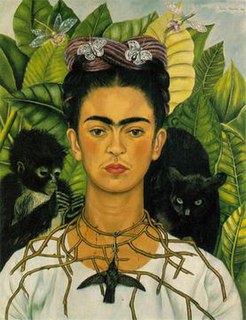 W
WSelf-Portrait with Thorn Necklace and Hummingbird is a 1940 painting by Mexican painter Frida Kahlo.
 W
WMany countries have featured insects on stamps. Insect related topics such as the mosquito eradication programme of the 1960s as well as graphic designs based on insects have also appeared. Many stamps also feature butterflies.
 W
WStill life with flowers on a marble slab is a 1716 floral painting by Rachel Ruysch. It is in the collection of the Rijksmuseum.
 W
WVenus Verticordia (1864-1868) by Dante Gabriel Rossetti is a semi-nude depiction of the goddess Venus, portrayed as a young woman with a golden halo and flowing auburn hair, surrounded by pink flowers in a dark, lush green garden. Her left breast is visible, the right obscured by the golden apple she holds in her left hand. In her right hand she holds an arrow, the point directed towards her own heart, and on which rests a small yellow butterfly. Other similar butterflies ring the halo surrounding her head, and another sits on top of the apple she holds.
 W
WThe Woman with the Spider's Web is a small 1803 print by the German Romantic painter Caspar David Friedrich, made into a woodcut by his brother Christian Friedrich, a carpenter and furniture maker, the same year.